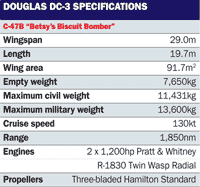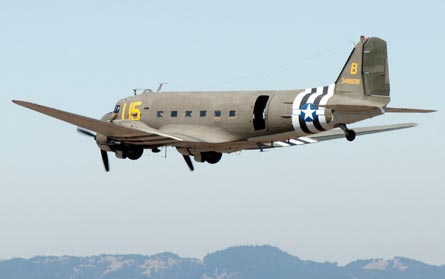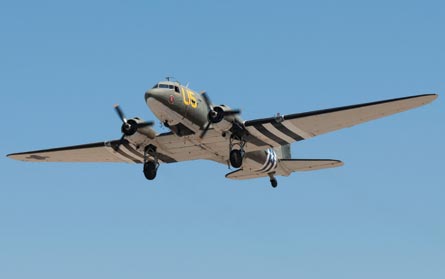Most aviation enthusiasts would recognise 17 December as the date the Wright brothers achieved controlled powered flight, and that same date holds significance for its contribution to the Allies victory in the Second World War.
Thirty-two years after the Wright brothers lifted off the Kitty Hawk Sands, in 1935 the first Douglas DC-3 lifted off near the beaches of southern California. Although developed and successful as a commercial airliner, the DC-3 found its glory as a military transport in the war. Designated the C-47 by US forces, it had many other nicknames and designations - Dakota, Skytrain and Gooney Bird to name a few. More than 16,000 DC-3s and its derivatives were built worldwide, with many in active commercial use to this day.
|
|---|
With the DC-3 fast approaching its 75th anniversary, one group wanted to mark it with a large celebration. In conjunction with the EAA's AirVenture 2010 Exposition (commonly called Oshkosh), The Last Time organisation is orchestrating a mass DC-3/C-47 formation flight. Over the skies of Wisconsin in late July more than 40 of this venerable type will mass for perhaps the last time.
As the date approaches, the list of participants is growing, with aviation legend Clay Lacy piloting Seattle's Museum of Flight's DC-2 to participate. This event would not be possible without the effort of untold numbers of volunteers and groups all trying to make Oshkosh's weather forecast read: fair winds, moderate temperatures and an overcast layer of DC-3s at 1,000ft (300m).
|
|---|
ESTRELLA MUSEUM
One participant in the reunion effort was generous enough to offer Flight International an in depth look at its extensive preparation efforts to help darken the skies over Oshkosh.
 Estrella Warbirds Museum is dedicated to the restoration and preservation of military aircraft, vehicles and memorabilia. Based at the former Estrella Army Air Corps Field near Paso Robles, California, the group has numerous static as well as flying historic military aircraft.
Estrella Warbirds Museum is dedicated to the restoration and preservation of military aircraft, vehicles and memorabilia. Based at the former Estrella Army Air Corps Field near Paso Robles, California, the group has numerous static as well as flying historic military aircraft.
In 2007 Glen Thomson purchased a C-47 for static and aerial display, with a goal of participating in the DC-3's 75th anniversary activities. Thomson donated the C-47 to the Gooney Bird Group, an organisation associated with the museum, but for liability reasons a separate legal entity. Their aircraft, serial number 348608 (now N47SJ), was one of 607 C-47s built in Oklahoma City in the Second World War. Delivered to the Army Air Corps in 1944, it arrived too late for the D-Day invasion.
Its late arrival, however, did not prevent it from making its contribution to the war effort. It flew in several operations, notably dropping paratroopers in Operation Market Garden and during The Battle of the Bulge. After the war it participated in the Berlin airlift before being transferred to the Belgian air force.
The French air force acquired it in 1953 for use in a personnel transport role. In 1967 the Israeli air force obtained it, storing it at Tel Aviv's Ben Gurion airport in a war reserve status. In 2001 it was purchased by a US aircraft company and moved to Edmonton, Canada.
While in good condition, what was remarkable about N47SJ was its low total flight time. In its 47 years of service to four air forces it had acquired less than 9,400 flight hours.
The Gooney Bird Group moved N47SJ to Paso Robles airport, the former Estrella field, in May 2007. Having been repatriated to its home country, the staff and volunteers of the Estrella museum went to work and restoration to US Army Air Corps configuration was completed in summer 2009. Once on display it was christened "Betsy's Biscuit Bomber". The name pays dual homage, to Betsy, the wife of museum and Gooney Bird Group co-founder Glen Thomson and to the C-47's role in dropping supplies to troops.
VETERAN SHAKEDOWN
Flight International was able to participate in two training and shakedown flights conducted by The Gooney Bird Group in preparation for Betsy's pilgrimage to Oshkosh. Both sorties were commanded by retired airline captain Sherman Smoot, now a vineyard owner.
|
|---|
In the cabin were 13 passengers, all volunteers at the museum or their friends. While in the US Air Force I was a parachute qualified forward air controller for several years. One of the highlights of that tour of duty was going through jumpmaster training at Fort Bragg/Pope AFB in North Carolina.
Having jumped aircraft ranging from Bell UH-1 helicopters to the Lockheed C-141 Starlifter, I was curious to see how the C-47 compared. For the first flight the left side troop door was removed, as we would simulate an airdrop once away from the airfield.
The cockpit was representative of a typical Second World War C-47, with the exception of the centre of the overhead panel, which was modified to hold a transponder and Garmin GPS unit. The 1,200shp (895kW) Pratt & Whitney radial engines were started off an external battery cart, a small bit of technique needed to smoothly get them to idle power.
The three-bladed Hamilton Standard constant speed propellers provided a nice cooling breeze while pre-flight checks were completed. Smoot and Quaid completed the required checks by reference to a laminated card. Smoot released the parking brake and taxied Betsy for take-off on Paso Robles Runway 19. Normal take-off flap setting for the C-47 is UP, with flaps used for short field operations.
Once aligned on the runway, Smoot locked the tail wheel and advanced the throttles while holding the toe wheel brakes. After brake release he promptly set a take-off power setting of 2,700RPM and 44in manifold pressure, slightly below the maximum of 2,700RPM/48in. Approximate take-off weight with 1,480 litres (390USgal) of gas was 10,000kg (22,100lb). At about 35kt (65km/h), with neutral yoke, the tail wheel lifted off the runway. At about 80kt Quaid called rotate, Betsy lifting off the runway at about 82kt.
Once airborne, Quaid initiated retraction of the hydraulically actuated main gear by moving the large red gear lever, located beneath the flap lever behind the co-pilot's seat. Accelerating through 95.6kt climb power was set, 2,350RPM/35in. A speed of 104kt was held during the climb to 2,500ft MSL, field elevation 840ft MSL. Once level, a power setting of 2,050RPM/27in allowed the C-47 to maintain an indicated airspeed of 121kt.
Smoot slowed the aircraft to 104kt for our simulated drop run. As we approached the drop zone, I attached myself to the overhead cable and performed a jumpmaster door check. Noise from the door open was relatively low, with little buffet felt inside the cabin. On actuation of the green light overhead the door, the jumpmaster would have signalled all 26 paratroopers to exit single file.
Once the jumpmaster had ensured all paratroopers were safely away, he would have exited to join the fray.
Smoot flew Betsy back to Paso Robles, where he set up for a downwind entry for Runway 19. At 1,000ft above the ground, on downwind, Smoot set the power at 2,050RPM/20in and commanded Quaid to extend the flaps to a quarter. As the base leg turn was started, Smoot lowered the nose and set up a 300ft/min descent while having flaps set to a half. On final with the airspeed decreasing through 95kt, three-quarter flaps were selected and a target speed of 87kt held.
Smoot's aim point was the runway threshold, and crossing it he retarded the throttles and slightly flared the aircraft. Betsy touched down in a two-point stance and forward yoke pressure was used to keep it in a level attitude. Quaid retracted the flaps and Smoot smoothly applied toe brakes to slow the aircraft. At about 30kt the tail wheel touched the runway. Approaching the runway turn-off point, Smoot unlocked the tail wheel and slowly taxied Betsy back to the museum's ramp.
During the 20min observation flight we had burned about 210 litres of fuel and I had gained valuable insights on how to fly the Second World War's most prolific transport aircraft.
With the passengers offloaded, Smoot took the right seat and Quaid took the left for some pattern work. After Quaid performed several touch and gos and a full stop landing, it was my turn to be tested by the 76-year-old C-47.
With the tail wheel locked, taxiing was relatively straightforward. I was able to keep the aircraft centred on the straight taxiways with some effort. With the tailwheel unlocked (free to castor) however, taxiing at any speed on the narrow taxiway proved challenging.
With good instruction from Smoot, I found using differential throttle to counter crosswind induced weather vaning and differential braking to turn the aircraft made ground manoeuvring manageable and 90° turns were fairly easy to negotiate when taken at slow speed.
After several minutes of taxiing, I lined up on Runway 19 for take-off. With the tailwheel locked, she tracked straight down the centreline as the power was advanced to the 2,700RPM/44in. The tail lifted off the runway at about 40kt, with rudder alone providing adequate directional control. Airborne at 87kt, Smoot retracted the landing gear and I accelerated the C-47 to a climb speed of 104kt.
Once level at 2,500ft MSL and 104kt, I was able to perform some gentle 20° angle of bank turns. Using ailerons to try and turn the aircraft was a lesson in futility. Increasing aileron deflection only served to generate adverse yaw.
While I had been prepared to co-ordinate the turn with rudder, I quickly learned that to turn the C-47 one only needed the rudder, with the ailerons providing style points at best. After a few minutes doing gentle manoeuvres, we set up for a downwind entry to Runway 19 for two visual circuits. Surface winds had picked up, and were a left quartering headwind at about 6kt for my circuits.
At the pattern altitude of 1,800ft MSL and abeam the runway on downwind, I set the power to 2,050RPM/20in. If I flew the pattern correctly, I would not need to touch the throttles until retarding them to idle for landing. I configured the aircraft as Smoot had advised, rolling out on final at about 400ft AGL with flaps set to three-quarters for the touch and go.
I used the runway threshold as my aimpoint, and placing it halfway down the windscreen centre pillar gave a good glidepath. At 87kt, pitch attitude on final was about 2° nose down. Crossing the threshold I retarded the throttles to idle, and pulled the nose to a level attitude. To my surprise the touchdown was smooth, my observations of the previous landings helped me correctly judge the flare height.
Small yoke inputs kept the tailwheel up as the flaps were retracted for the take-off portion of the touch and go. Once airborne, the gear was retracted, and after a long upwind leg I turned Betsy to enter the pattern for my full- stop landing.
The touchdown on the full stop was smoother than the first, as I concentrated on keeping Betsy on the centreline. Smoot retracted the flaps and I applied the toe wheel brakes to slow to a safe, taxi speed. Taxi back to the museum's ramp was uneventful, but did demand most of my nascent tail dragger handling skills.
LESSON LEARNED
I found the C-47 to be a solid predictable aircraft that required the use of ailerons to co-ordinate turns. Taxiing was the most challenging aspect of my flight experience, hammering home the adage that the flight is not over until the parking brake is set.
Estrella Warbirds Museum and its Gooney Bird Group have gone to great lengths to prepare Betsy's Biscuit Bomber for its day in the sun at Oshkosh. Their efforts will surely be appreciated by all those fortunate enough to see her motor through Wisconsin's skies for what may well be the last big C-47 gathering.
Source: Flight International






















